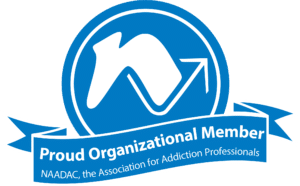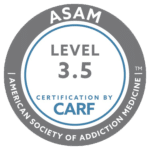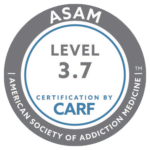Addiction is a complex disease that affects nearly every aspect of brain functioning and health. Nowhere is this more apparent than at the brain’s reward center. This brain region within the ventral striatum focuses on motivation and reward. It plays a significant role in determining what we do, how easy it will be, and how good we feel afterward. The actions of the brain’s reward center are driven by neurotransmitters and enhanced by neuromodulators. Endorphins are classified as both.
What Are Endorphins?
Helpful, adaptive, and naturally produced by your brain, endorphins are both messengers and powerful pain relievers. So, whether you’ve just finished a hard workout, indulged in a decadent dessert, or twisted your ankle, the endorphins that flood your body will give you a sense of calm and ease. In addition, the protective effects of endorphins help people deal with stress, pain, anxiety, and more. Fitness enthusiasts often speak of the “endorphin rush” or the.” This is a surge of endorphins that occurs after invigorating workouts. Similar effects can be obtained by being physically intimate with your partner, eating a good meal, or engaging in other positive, healthy, and life-affirming activities.
The brain uses endorphins and other neurotransmitters to encourage reward-worthy activities. Powerful, mood-boosting chemicals are released as a reward whenever you do something good for your body or overall well-being. To experience these feelings again, people often return to the same beneficial activities that triggered the reward. For example, endorphins and neurotransmitters like dopamine cause people to seek foods like chocolate when distressed, return to the treadmill when they want to feel emotionally balanced and uplifted, and spend quality time with their loved ones, among other things. Endorphins also account for people’s ability to do remarkable things under intense stress that are impossible in normal conditions. For instance, a person might be able to lift a heavy object, such as a vehicle, to rescue a trapped loved one when flooded with endorphins.
How Endorphins Affect Your Brain
One of the most critical jobs of endorphins is quieting the pain nerves. In this role, endorphins are natural opioids that impact pain perception. They do so by landing on individual docking stations at the end of each nerve, known as receptors. Receptors typically capture neurotransmitters that activate nerve cells so that an electric signal carries the pain response forward. However, opioid receptors work differently. They do quite the opposite. They block the electric signals that carry the pain response. In short, they stop the message of pain from being transmitted so that no discomfort is felt. Moreover, when endorphins are attached to your pain receptors, another “feel good” neurotransmitter called dopamine is also released.
Unfortunately, endorphins and all other neurotransmitters have their limitations. As a result, they can become both overwhelmed and overworked. When this happens, the pain response exceeds the brain’s natural ability to override it. As a result, pain, stress, or anxiety are felt, and there’s no reliable way to resolve them. This is often when people seek pain-relieving drugs that are either prescribed by their doctors or purchased illicitly.
Endorphins in Addiction: The Mu-Opiate Receptor
People with medical conditions that produce chronic pain are often prescribed opioid medications that assume the role of pain-relieving endorphins. These drugs bind to the opioid receptors and stop pain outright. However, they also impact other aspects of the body’s functioning. Opioid medications act on the delta-opiate receptor, kappa-opiate receptor, and mu-opiate receptor. Of the three, the mu-opiate receptor is most relevant to addiction and its struggles.
This receptor is responsible for all significant effects of opiates and synthetic opioids, including constipation, euphoria, depression, and pain relief. When the mu-opiate receptor is removed from the equation, none of the effects of opiates occur, including the heightened euphoria these drugs produce. This understanding has been vital in the treatment of opiate and opioid addiction.
Endorphins in Recovery
While many people expect physical withdrawals to be the most difficult part of recovery, gradually returning the brain to normal functioning is often the more significant challenge. Shortly after a person’s physical withdrawal symptoms have ended, post-acute withdrawal symptoms (PAWS) kick in. These are primarily psychological withdrawal symptoms that include:
- Depression
- Anxiety
- Lack of Motivation
- Lack of Incentive
- Trouble Sleeping
- Malaise
- General Discontent
Unmanaged PAWS accounts for the high rate of relapse in early recovery. People may wonder why they’ve worked so hard to reclaim their lives and health yet fail to feel better than before they stopped using. Some wonder if they’ll ever be able to feel good again.
Substance use disorder (SUD) and alcohol use disorder (AUD) overwhelm neurotransmitters causing them to burn out. Unfortunately, burned-out neurotransmitters often misfire or maybe under-produced. In the case of endorphins, people are also conditioned by substance abuse to expect higher amounts of these “feel-good” chemicals and higher pain-blocking effects. Having the body’s pain receptors completely muted throughout the duration of substance abuse significantly lowers a person’s general pain tolerance. Conversely, having these receptors suddenly turned back on because of abstinence is jarring. Thus, for a person who’s been using opiates or opioids, even moderate amounts of physical discomfort can be downright intolerable.
There are two primary types of physical pain. Nociceptive and neuropathic. Nociceptive pain is the most common type of pain. It develops in response to the body detecting harmful stimuli. Most often, nociceptive pain is caused by external injuries, such as cuts, burns, broken or fractured bones, and other physical injuries, and feels achy, sharp, or throbbing. Unlike nociceptive pain, neuropathic pain is not a response to outside stimuli. Neuropathic pain is the result of damage to nerves or the nervous system. Many different conditions and diseases can cause it. Some common causes include alcoholism, diabetes, nerve compression, and various central nervous system disorders. Neuropathic pain can be spontaneous or evoked, often described as shooting, burning, tingling, and numbness.
Early recovery is mainly about letting the brain and its chemistry normalize. For example, certain neurotransmitters, such as dopamine, can experience a complete rebound within 12 to 14 months. In recovery, people who’ve used substances that have altered the natural release of endorphins are often encouraged to engage in healthy, reward-worthy, and biological mood-boosting activities. There are many positive and proactive ways to fight through the depression, malaise, and discomfort of PAWS and other secondary withdrawal symptoms.
Waiting for the Return of Normal Neurotransmitter Activity
At Granite Recovery Centers, we take a multi-pronged approach to mitigating the challenges of early recovery. We use evidence-based therapies and interventions to help our clients deal with and manage discomfort while their endorphins and other neurotransmitters rebound. These include the use of:
- Dialectical Behavior Therapy for improving natural distress tolerance
- Medications for Blocking the mu-opiate Receptor
- Cognitive Behavioral Therapy introduces healthy coping skills
- Structured Exercise for inciting natural endorphin release
- Social Activities that naturally trigger the brain’s reward center
Although not technically a muscle, the brain is very much like one because the more it’s used, the stronger and healthier it becomes.
What You Can Do to Help Speed Things Along
The importance of endorphins in addiction recovery can be found right in their name. This word is a fusion of “endogenous” and “morphine.” Endogenous means “of the body,” Thus, endorphins are ultimately your body’s natural morphine. When you want feelings of calm, relaxation, and euphoria, or when you genuinely need pain relief, your body is chemically capable of rising to the challenge. You must allow it to do so.
In recovery, waiting for the brain’s chemistry to rebound is made easier with withdrawal medications, treatment for co-occurring disorders, and countless other forms of support. You can expedite this process by engaging in activities that promote balanced brain functioning and health. These include:
- Actively participating in both group and private counseling sessions
- Practicing good nutrition and sleep hygiene
- Engaging in challenging physical exercise
- Forming meaningful bonds with others
- Planning for the future
- Setting S.M.A.R.T. goals
- Taking steps to meet your goals
- Acknowledging your accomplishments
Although each of these activities is seen as helping individuals build sober and sustainable lives, they also assist in the healing and recovery of the brain. The more you actively participate in various rehab services, the easier it becomes for your brain to adapt to your new and improved way of living.
Endorphins Are an Integral Part of Your Recovery
Understanding how addiction affects the brain and its chemistry highlights the importance of seeking help. For example, the pain-blocking and mood-boosting effects of opiates, opioids, alcohol, and other substances impact how people perceive stress, cope with it, and manage their lives. Moreover, with the brain conditioned to view substance use as a reward-worthy behavior, there’s often a strong motivation to return to substance use even when there’s no motivation for doing much else.
Reinstating endorphins as one of your natural mechanisms for pain relief and management is essential. Endorphins don’t just block pain and the perception of it. They also contribute to feelings of pleasure. When people experiencing PAWS grow tired of battling depression and malaise, and when there’s a general lack of contentment and happiness, chemical changes within the brain often prevent endorphins from doing their job.
Mood balance and the neurological activities that drive happiness can be restored with time, adequate support, and the right treatments. You can live a full and happy life without drugs or alcohol.






